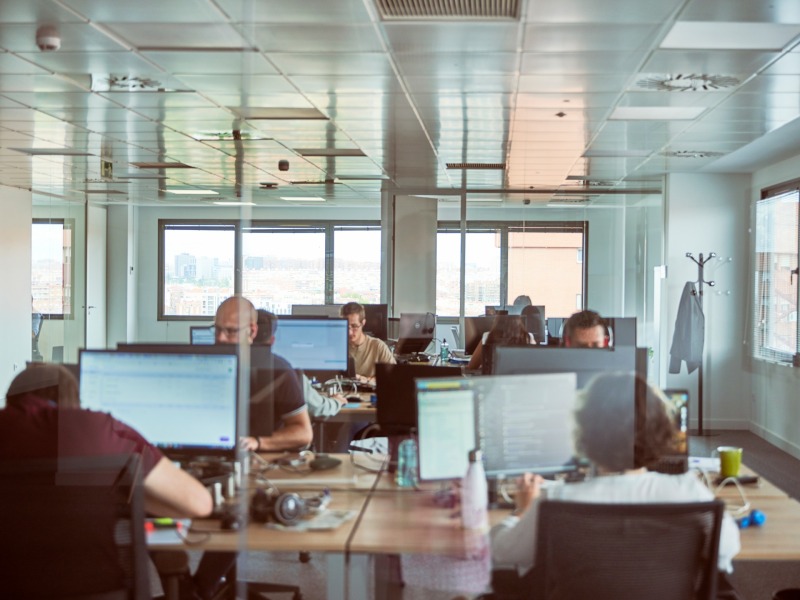RWE Generation SE (RWE) is responsible for power generation based on gas, hard coal, hydropower and biomass within the RWE Group. The company’s approximately 3,000 employees operate power plants in Germany, Great Britain, the Netherlands and Turkey. Through the conversion of power plants and the successful development of new storage technologies, RWE Generation SE is making a key contribution towards the ambitious goal of RWE as a whole – to be climate-neutral by 2040.

RWE Safety Street VR
RWE Generation SE
Implementation of a virtual reality training centre for safety at work
Challenge
RWE Generation places great emphasis on the safety of its employees and operates what are known as “Safety Streets”; physical training centres in which employees receive training that is both realistic and effective. These training centres have various stations at which the employees are shown how to behave both safely and appropriately when working in power plants.
The low degree of scalability and the fact that the employees need to travel to the training centre, which costs time, pose a problem here. Because RWE is committed to ensuring its employees are fully prepared to deal with everyday challenges in their working environment, it has brought adesso on board to help develop a virtual reality safety training called the RWE Safety Street VR.
Solution
Innovative technologies have had a strong influence on the working world in recent years and have helped to improve safety at the workplace. One such example is the use of virtual reality (VR) to provide employees with training in how to better perceive safety risks. adesso has already successfully implemented such a project at RWE.
Based on the physical Safety Street, the IT experts first designed an initial proof of concept using virtual reality to demonstrate the feasibility of the idea. This gave RWE its first taste of VR technology and put the company in a better position to determine whether this could be an acceptable alternative to or even an improvement on the current situation.
The feedback was entirely positive and saw the proof of concept further developed to become a fully-fledged product. During the development phase, adesso expanded the number of possible safety briefings.
The project was implemented with Unity, a runtime and development platform from US company Unity Technologies. This real-time 3D platform was originally intended for gaming, however provided an ideal basis for the high-quality graphics of a VR environment. The high-performance Meta Quest 2 (formerly Oculus Quest 2) VR goggles were used, with other models generally also a possibility.
This state-of-the-art hardware and software will enable RWE employees to recognise and report safety risks and hazards in the virtual Safety Street. While exploring the 3D worlds in complete safety, the impact of these risks and hazards, such as inadequately secured loads falling from a height, can be experienced digitally and thus better understood.
At the end of the tour, the employees receive an assessment graded according to the number of safety risks they found and reported. The gamification approach ensures the virtual safety training is both entertaining and motivational.
The Virtual Reality Safety Street is the perfect addition to Mission ZERO’s physical Safety Streets. It allows us to train in difficult environments without putting the safety of the participants at risk. It has become a very impressive training platform, successfully combining the serious topic of safety with immersive game elements.
Michael Figgel l Head of Safety l RWE Generation SE

Result
The use of VR means RWE employees receive safe, interactive training which facilitates an improvement in learning and a greater interest in work safety. The virtual training environment represents a valuable tool for RWE, helping to raise safety awareness among employees and prevent accidents at work.
This IT Generation is already familiar with the enormous value of virtual reality when it comes to the improvement of learning and operational safety. For us, it represents a key strategic technology for establishing an interactive learning environment.
Sebastian Niestrath l Head of IT l RWE Generation SE

There are further advantages for RWE, with the Safety Street VR demonstrating considerably higher scalability than the physical Safety Street. Higher participant numbers do not require the acquisition of new premises, but can be easily accommodated with the purchase of additional VR headsets. This makes it possible to train more employees without the investment of additional resources such as buildings, facilities and equipment.
Mobility is another advantage to the RWE Safety Street VR. This is a location-independent solution and rules out any additional trips to a training centre. Not only does this save time and money, it represents a more flexible solution that facilitates training at any company premises. The clever use of cutting-edge technology also boosts the image of RWE as an innovative employer.
It has been scientifically proven that virtual reality training is more effective than more traditional learning methods, as it boasts a considerably higher retention rate and allows participants to learn how to behave correctly in hazardous situations in a completely safe virtual environment.
Marta Szpindor l Head of IT Business Innovations l RWE Generations SE

The RWE Group is a world leader in conventional and renewable energies. With wind parks, solar power and battery storage systems across the globe, green energy already represents the core business of RWE.

Do you have any questions?
There is no website or brochure which can replace a personal meeting to talk about your goals and topics. We are looking forward to an appointment on site.